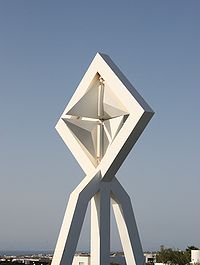- César Manrique
-
César Manrique (pronounced: [ˈθesar manˈrike]) (24 April 1919 in Arrecife, Lanzarote - 25 September 1992 in Tahíche, Teguise) was an artist and an architect.
Contents
Biography
Manrique grew up in the area of San Ginés lagoon. At age 23, he participated in his first exhibition in Arrecife. He attended the University of La Laguna. In 1945, Manrique attended the art school San Fernando in Madrid for five years. With Nelson Rockefeller in 1964, he visited Houston and New York in the "Catherine Viviano" gallery.
Manrique visited and learned from famous persons including Rita Hayworth, King Hussein of Jordan, Helmut Kohl, Spanish Prime Minister Felipe González, Luis Ibáñez, Andy Warhol, Barbara Rosse and Alfredo Kraus.
Manrique had a major influence on the planning regulations in Lanzarote, when he recognised its tourist potential and lobbied successfully to encourage sympathetic development of tourism. One aspect of this is the lack of high rise hotels on the island. Those that are there are in keeping with the use of traditional colours in their exterior decoration.
Manrique died in a car accident near the Fundación, his Lanzarote home in 1992. He was aged 73.
Fundación César Manrique
The César Manrique foundation was set up in 1982 by César Manrique and a group of friends but wasn't officially opened until 1992, after Manrique was killed. The foundation, based at Manrique's home before he moved out for a quieter life, is a private, non-profit organisation set-up to allow tourists access to Manrique's home. The foundation is also an art-gallery featuring both art created by Manrique himself, as well as art Manrique acquired over his life. The gallery includes original sketches by Pablo Picasso and Joan Miró. The money that the foundation makes from ticket sales, goes into Lanzarote and helps to raise awareness about art as well as being used to fund the foundation's "artistic, cultural and environmental activities".
Manrique's home itself is built within a 3,000 m2 lot, on the site of the Lanzarote eruptions in the 18th century and was created upon Manrique's return from New York in 1966. The rooms on the first floor, including the artist studios, were created with the intention of keeping with Lanzarote traditions, yet making them more modern with open spaces and large windows. The "ground floor", more appropriately titled the "basement", contains five areas situated within volcanic bubbles, the rooms bored into volcanic basalt. There is a central cave which houses a recreational area, including a swimming pool, a barbecue and a small dance floor.
Once outside the main house, the visitor comes to the outside area, where there is a small square with a fountain in the middle before approaching a small café area and the visitor shop. This area was once César Manrique's garage.
One of the foundation's fundamental missions is to oppose the spread of high-rise concrete across the Spanish coastline and her island. The foundation recently brought attention to 24 illegally erected hotels in Lanzarote.[1]
Honors
- 1978 World Prize for Ecology and Tourism (Weltpreis für Ökologie und Tourismus) in Berlin, Germany
- 1982 Netherlands Laureate Van D´Abeod, the Netherlands
- 1986 Europa Nostra Prize European parliament
- 1989 Art Prize, Canarian government
- 1989 Fritz Schumacher Prize at the University of Hanover, Germany
Works
In Lanzarote
- Casa Museo del Campesino (next to this stands one of Cesar Manriques most famous sculptures named "Fecundidad").
- Casa Museo Monumento del Campesino.
- Mirador del Rio (built in 1973 overlooking the neighboring island of Graciosa).
- Jameos del Agua (concert venue/nightclub for 600 persons in a cave).
- Jardín de Cactus (a cactus garden home to over 1,100 different varieties of cactuses near Guatiza.
- Taro de Tahíche (Manrique's house near Teguise).
- Museo Internacional de Arte Contemporaneo (International Museum of Contemporary Arts in Castillo de San José featuring the paintings of Miró, Millares, Mompó, Oscar Dominguez, Gerardo Rueda, Eusebio Sempérez, Augustín Cárdena and Manrique).
- El Almacén.
.
- Garden and swimming pools of the five-star hotel Las Salinas in Costa Teguise.
- El triunfador (built in 1990 in the area of Fundacion César Manrique, a sculpture).
- Juguetes del viento (built in 1992 in Arrieta, windmill).
- El Diablo symbol of the Timanfaya National Park.
- El Diablo Restaurant (Uses volcanic heat to cook; also has an outdoor volcanic barbecue pit Timanfaya National Park.
Outside Lanzarote
- Lido Martiánez a.k.a Lago Martiánez (1977, Large "semi natural" open air sea-water pool complex in Puerto de la Cruz, Tenerife).
- Playa Jardin (Volcanic beach and sub-tropical gardens complex in Puerto de la Cruz, Tenerife).
- La Vaguada (1983).
- La Peña (1989, a restaurant and belvedere on El Hierro).
- Mirador del Palmarejo (1989, a lookout point in La Gomera).
- Canarian Pavillion (1992, Expo 92, Seville, Spain).
Additional images
-
Wind sculpture (Las Palmas de Gran Canaria)
References
- ^ Building craze threatens to end Lanzarote's biosphere status The Independent. 7 July 2010
- César, Manrique Arquitectura inédita
- Lancelot Internacional, Especial: César Manrique, Lanzarote, 3. Revisada 1996, Lanzarote. Idiomas: Español, Inglés y Alemán (3rd revision 1996, Lanzarote. Languages: English, German and Spanish).
External links
Categories:- People from Lanzarote
- 1919 births
- 1992 deaths
- Spanish architects
- Spanish painters
- Spanish sculptors
- Road accident deaths in Spain
Wikimedia Foundation. 2010.












